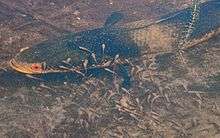Channa marulius
Channa marulius (bullseye snakehead or great snakehead) is a large species of snakehead native to South Asia.[2] Populations in Southeast Asia are now regarded as separate species.[3][4] It has been introduced to the United States, where it is considered an invasive species.[5]
| Channa marulius | |
|---|---|
 | |
| Bullseye snakehead protecting young | |
| Scientific classification | |
| Kingdom: | Animalia |
| Phylum: | Chordata |
| Class: | Actinopterygii |
| Order: | Anabantiformes |
| Family: | Channidae |
| Genus: | Channa |
| Species: | C. marulius |
| Binomial name | |
| Channa marulius (F. Hamilton, 1822) | |
| Synonyms[2] | |
| |
Taxonomy
_2347.jpg)
C. marulius—as traditionally defined—is a species complex. A study published in 2017 showed that C. pseudomarulius, formerly regarded as a synonym of C. marulius, is a valid species from the southern Western Ghats.[6] A genetic study published the same year showed that C. marulius consisted of three clearly separated lineages (not counting the already separated C. pseudomarulius).[7] One of these is C. aurolineata, revalidated in 2018 for the populations in rivers of Burma (separated from the more western C. marulius by the Indo-Burman Ranges),[3] and the other was described as a new species, C. auroflammea, from the Mekong basin in 2019.[4]
In India
It is a widespread native fish. In South India, it is commonly found in reservoirs. It is found in Pechipparai, Chittar, Manimuthar, Bhvani and Mettur dams of Tamil Nadu and Thenmalai, Neyyar and Idukki dams of Kerala. It can also be found in the reservoirs of Himachal Pradesh such as the Pong Dam (Maharana Pratap Sagar), where it is known locally as soal. C. marulius is commonly known as giant murrel. In Assam it is locally known as xal (Assamese: শাল). They are faster-growing fish than most of the other species of the genus. At times they are sold live and fetch high prices in the market, due to their excellent tasting flesh and lack of fine bones. They are suitable for intensive culture due to their air-breathing habit.
In Andhra & Telangana it is called Korrameenu, and is quite common in lakes and reservoirs.
In the United States
In the United States, it can be found in waterways throughout South Florida originating from the C-14 Canal where the species was first introduced. Chances of this warm water species migrating to Northern Florida are slim. The bullseye snakehead has not been documented outside of Florida in the United States.
References
- Chaudhry, S. (2010). "Channa marulius". IUCN Red List of Threatened Species. 2010: e.T172328A6868796. Retrieved 23 December 2019.
- Froese, Rainer and Pauly, Daniel, eds. (2006). "Channa marulius" in FishBase. January 2006 version.
- Adamson, E. A. S. and R. Britz (2018). The snakehead fish Channa aurolineata is a valid species (Teleostei: Channidae) distinct from Channa marulius. Zootaxa 4514 (4): 542-552.
- Adamson, E.A.S., R. Britz and S. Lieng (2019). Channa auroflammea, a new species of snakehead fish of the Marulius group from the Mekong River in Laos and Cambodia (Teleostei: Channidae). Zootaxa 4571(3): 398-408.
- "Channa marulius". Invasive Species Specialist Group. 24 May 2009. Retrieved 17 July 2010.
- Britz, R., E. Adamson, R. Raghavan, A. Ali and N. Dahanukar (2017). Channa pseudomarulius, a valid species of snakehead from the Western Ghats region of peninsular India (Teleostei: Channidae), with comments on Ophicephalus grandinosus, O. theophrasti and O. leucopunctatus. Zootaxa 4299(4): 529-545.
- Conte-Grand, C., Britz, R., Dahanukar, N., Raghavan, R., Pethi-yagoda, R., Tan, H.H., Hadiaty, R.K., Yaakob, N.S. & Rüber, L. (2017). Barcoding snakeheads (Teleostei, Channidae) re-visited: Discovering greater species diversity and resolving perpetuated taxonomic confusions. PLoS ONE, 12 (9): e0184017.
External links
| Wikispecies has information related to Channa marulius |
